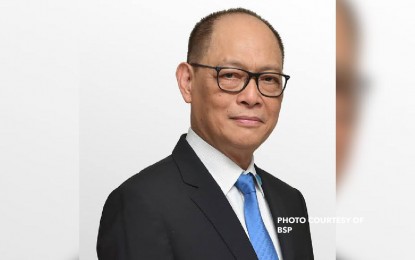
Bangko Sentral ng Pilipinas Governor Benjamin Diokno
MANILA -- Bangko Sentral ng Pilipinas (BSP) Governor Benjamin Diokno believes that achieving the government’s 6 to 7 percent growth target for 2019 is “still doable” after a recovery in the third quarter.
The Philippine Statistics Authority (PSA) on Thursday reported a 6.2-percent domestic output, as measured by gross domestic product (GDP), in the third quarter this year, higher than year-ago’s 6 percent and a turn-around from the deceleration to 5.5 percent in the previous quarter.
Average growth in the first three quarters stood at 5.8 percent.
In a statement, the central bank chief said the third-quarter growth “exceeds the consensus forecast which indicates catch-up plan is working.”
“The 6-percent full year GDP growth target is a tall order, after a slower-than-expected first half, but still doable,” he said. “In any event, the Philippines growth performance this year is one of the fastest among relatively large economies, amidst a slowing global economy.”
The consensus forecast for the third quarter is a 6-percent growth.
Among the sectors, growth from July to September this year was driven by Services, which posted the highest expansion at 6.9 percent. This was followed by the Industry, 5.6 percent; and the Agriculture, Hunting, Forestry and Fishing, 3.1 percent.
The government implemented a catch-up spending program focused on the infrastructure spending of the Department of Public Works and Highways (DPWH) and the Department of Transportation (DOTr), to lift expenditures after GDP slowed in the first half of the year due to the delay in the approval of this year’s national budget. This was only signed into law last April 15.
Expenditures last September posted a double-digit growth of 39.1 percent year-on-year to PHP415.1 billion.
The end-September figure of PHP2.626 trillion was 2.14 percent short of the PHP2.684 trillion programmed for the nine-month period.
GDP growth in the first quarter this year slipped to 5.6 percent from quarter-ago’s 6.3 percent. It further slowed to 5.5 percent in the second quarter, bringing the first half output to 5.5 percent.
Spending recovery
ING Bank N.V. Manila senior economist Nicholas Mapa said household consumption, which accounts for about 57.4 percent of economic activity, played a big part in domestic growth recovery in the third quarter after it rose 5.9 percent.
He said household consumption shared about 3.3 percentage points to the third-quarter output.
He attributed the robust household consumption to sustained drop of inflation rate, which decelerated to 0.8 percent as of October from month-ago’s 0.9 percent.
After peaking at 6.7 percent in September and October last year, the rate of price increases continued to post slower growth, although an uptick was recorded last May when it rose to 3.2 percent from month-ago’s 3 percent.
Average inflation to date is 2.6 percent, at the lower half of the government 2 to 4-percent target band until 2021.
Mapa said domestic growth can also get an additional boost from government spending in the last quarter of the year after the government implemented a catch-up program as economic managers commit to a deficit to GDP ceiling of 3 percent of GDP this year.
Government deficit as of end-September amounted to PHP299 billion, 18.03 percent short of the PHP364.7 billion programmed for the period.
Mapa said achieving the lower end of the government’s growth target band this year is not impossible since the third-quarter output helped “to keep the string of strong growth alive.”
“In order to complete the growth picture however, the PHL (Philippines) will need to see a positive contribution from the investment picture, which has languished in contraction for two straight quarters,” he said.
The economist said “monetary easing and improving investor sentiment will likely lift capital formation to close out the year with an accelerated pace of capital formation growth expected in 2020 as recent Bangko Sentral ng Pilipinas (BSP) rate cuts feed into the economy.”
“(Socioeconomic Planning Secretary Ernesto) Pernia estimates that the PHL will need to post a 6.7-percent growth print in 4Q (fourth quarter) to get full year growth above 6 percent and we believe this remains highly achievable if the economy finally fires on all cylinders once again,” he added.
BSP rate cut
With the growth recovery, ANZ Research said the central bank was given a leeway “to pause on further monetary easing and assess the impact of previous rate and reserve requirement ratio (RRR) cuts.”
“At the same time, the favorable inflation environment provides sufficient room for the central bank to resume easing should growth weaken anew,” it added.
BSP’s policy-making Monetary Board (MB) has reduced the central bank’s key policy rates by a total of 75 basis points so far this year, after raising it by 175 basis points last year, given the inflation slowdown and the belief that growth remains firm despite weaker output in the first half of the year.
To date, the BSP’s overnight reverse repurchase (RRR) facility is at 4 percent, the overnight repurchase facility is 4.5 percent and the overnight deposit rate is 3.5 percent.
The MB has also decided to slash banks’ reserve requirement ratio (RRR) as much as 400 basis points, with the last 100 basis points effective by December this year.
This year, RRR of universal and commercial banks (U/KBs) and thrift banks (TBs) have been lowered by 400 basis points, non-bank financial institutions with quasi-banking functions (NBQBs), 300 basis points; rural banks (RBs’) by 200 basis points; and cooperative banks by 100 basis points. (PNA)
